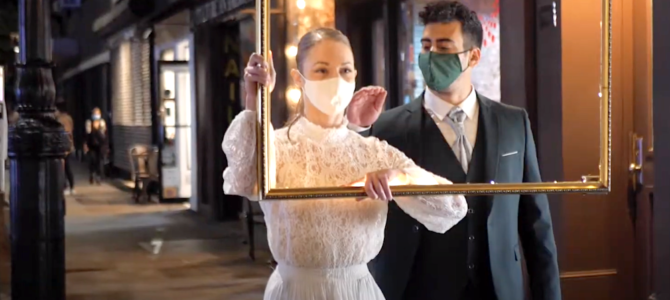
At its best, theater can transport consciousness and emotions to a new world, where viewers inhabit the same time and place as the characters on stage. Theater is an art form synonymous with New York City, so when COVID-19 shut it down, the arts community tried to move online with Zoom calls and Google meets.
Watching live theater online is like listening to live music on the telephone: entirely pointless. With Broadway theaters slated to be dark until May 2021, theater-lovers have had little to fill their imaginations.
Enter “Voyeur,” an immersive theater put on by Bated Breath Theatre Company that runs, in good weather, as an outdoor walking tour through Manhattan’s West Village. It was made for New York City in pandemic times, but it’s set in 1899 in Paris. The hero, the downtrodden artist Henri de Toulouse-Lautrec, is at the end of his syphilis-ridden days.
“I spent my time in lockdown thinking I couldn’t do this,” Mara Lieberman told me, noting how much she hates Zoom. She’s the executive artistic director of the company and the lead writer. “I create in time and space with bodies. So what are you going to do? And I know there’s got to be a way to do this, which is why the idea for ‘Voyeur.’”
She continued: “If the actors are behind the windows, if we have to be outside, then OK. There’s a lot of opportunities and there’s a lot of hunger and a lot of need. My hope is that this play will be a little medicine dropper full to New Yorkers who see it.”
New York City, Or Paris?
As a New Yorker and theater aficionado, I loved seeing the park and city come alive through the lens of a dirty time in Paris. It was as though we were walking through 1899 Paris during a pandemic. We carried votive candles and traversed the darkness, through a small cluster of kids skateboarding, laughing, and drinking. Part of the Big Apple emerged into its own filthy grandeur.
“I work in a really unusual way,” Lieberman told me, “and I birth these projects.”
Audiences follow a woman in something of a “Moulin Rouge”-inspired costume. She cranks an organ grinder as she leads the small, socially distanced, masked audience from Christopher Street east, ending up in Washington Square Park before entering a building, where the audience views a lone dancer on stage from the vantage point of a wide balcony.
“Voyeur” did not emerge on its own, but was inspired by a piece Lieberman and her company were running at another venue, called “Unmaking Toulouse-Lautrec.” Like “Voyeur,” that show was also created for its performance location.
“This piece is not a translation of that piece to the streets of New York; it takes place during a specific moment in the ‘Unmaking of Toulouse-Lautrec.’ In his story, near the end of his life, he was syphilitic, he had alcoholism, and he was dying. He was burning the candle, and he knew it, and he didn’t want to stop.”
The show emits that feeling of theater unbound: It doesn’t want to stop simply because the entire infrastructure of the city and her leaders are closed to artistic creation.
“There’s a moment in ‘Unmaking Toulouse-Lautrec’ where he’s drunk,” Lieberman said, “and he goes to the bar to find his friend Jane and embarrasses her in front of the crowd. He’s terribly disoriented and drunk, and she tries to take him home, but he says ‘No, I want to go out!’ And he slams the door.”
She continued: “And then all of a sudden, the space turns into what a club would be like now, and we have this techno can-can, and this is a big finale. And in the middle of this, he’s really hootin’ and hollerin’ and loving it, and he’s totally drunk. And then all of a sudden, there’s this moment where he has a rupture. His ears pop, and psychologically he has a break.”
Lieberman went on, saying, “So this version, for me, takes place during that moment when he has that break, and then the rest of the play is him sitting in the asylum and having these memories. So it’s really a journey into his final memories. If someone said you could only take six memories with you, which six would you take? — that’s kind of what this show is.”
The Village Is a Metaphor
With so much of the city shut down to in-person experiences, I asked Lieberman how she ended up at the storied cabaret venue The Duplex and what made her choose the West Village for her stage.
“The West Village in some ways reminds me of Paris,” Lieberman responded. “Anne Bogart, my teacher, used to say, you don’t point at the sun — you point at something the sun shines on. So if I was going to make a piece about New York and how much New York is still alive and how much we’ve come through with COVID, that’s just too heavy-handed right now.” She went on:
That just cannot be digested right now, but making a piece about a time in Paris, and the Village resembles Paris in some ways, at the time of the Belle Epoch, when people were carefree, inventing new forms of art, sharing each other’s company, classes were starting to intermingle. … To me the metaphor to that is pre-COVID, we didn’t even know we were in the Belle Epoch, when we could be in the same room together, talking to each other, dancing with one another.
When Lieberman began hunting for the right venue, the Duplex was on board right away — and it was a great match. While “Voyeur” isn’t the only live theater show in New York right now, in terms of a long-running full production outside, “Voyeur” stands alone.
‘Voyeur’ Brings Theater to the Streets
What struck me most was how many traditional theatrical elements from stage plays could be translated to a walking tour, without many physical pieces. Lieberman, her cast, and her crew were able to create a breathtaking and stunning atmosphere with only costumes, sound, and a little bit of lighting. The Village is already an amazingly lively place to be, and the immersive “Voyeur” experience made it all the more vibrant. The artists truly made you believe you were in 1899 in Paris.
Lieberman said she spends a lot of time “trying to find answers to theatrical problems that are in the excellent zone, not just good enough. And I am fastidious, and I don’t stop until I find a theatrical solution. No doesn’t frighten me; I find restrictions very liberating.”
Many audiences have said they felt transported during the walking tour, Lieberman told me. “The unpredictable and the unexpected can happen because you’re on the street — and it’s never the same show twice,” she said. “The fact that it can feel so full of wonder makes me so happy. Not only are we doing something well in that moment, but we’re tapping into that energy that runs underneath the sidewalks.”
‘Voyeur’ Is Gritty and Real
“Voyeur” has the feeling of the kind of art I like best. It’s scrappy and dirty — but the heart is there, the beating realness of blood and flesh.
“I want people to understand that Toulouse-Lautrec could be anywhere in the park,” Lieberman said. “He could be the person smoking the joint, or on the skateboard. He was part of the outcast, he was part of the underbelly of Paris. And that’s the thing: He belonged to a time and space where he was living in his own context. He wasn’t just some kind of fetishized artist or iconic character. He was a real person in a real time and space and developing a space and using the space as inspiration, and that’s what we are doing.”
Lieberman is concerned about the human cost of the pandemic on New York and wanted to acknowledge in some of the graver moments “the fact that there are a lot of people who were walking the streets this time last year who now aren’t.” As for the future of the arts scene in New York, she said she hopes to “heal some of the pain that COVID has caused and the drought of art.”
That’s why the ending is so quiet, she told me. “I usually end on a big fanfare, but this is really important that we come back to this figure who is dying and saying goodbye to his life and his work. It’s a little bit like that’s what the sun was shining on.”









